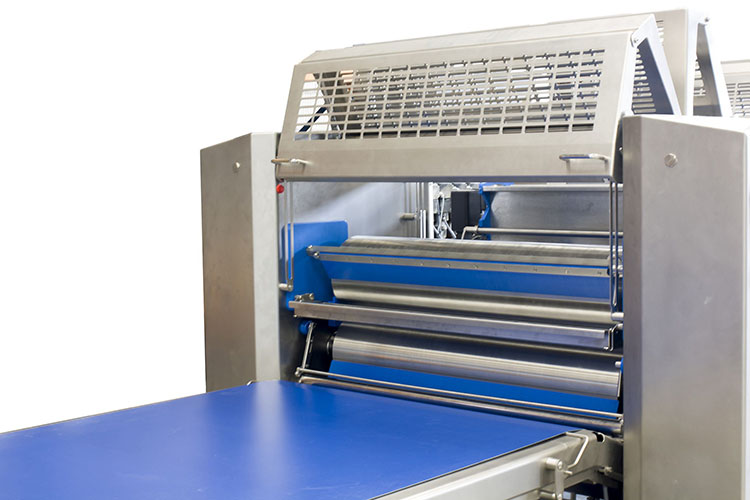
Secondary virtues such as user-friendliness, hygiene, robustness and workplace safety are becoming increasingly important in bakery machine construction. Examples include Rademaker’s laminating and make-up lines.
The fact that a line delivers the required product in the required quality, regardless of whether that is low or high, is taken for granted nowadays, or is even one of the knockout criteria. When making investment decisions, any baked goods supplier who must offer delivery reliability and cost leadership – and these criteria apply worldwide in view of the highly centralized sales structures in the retail trade and food service – will for his/her part look for quality, efficiency in the form of high availability, and possibly for flexibility as well if contract terms are not very long, and will calculate the ownership cost.
Fewer spare parts are only one item in this long list. However, even the most numerically obsessed will have realized by now that this is not purely a definition or calculation task, but in practice depends on many details, not least of which is the way the operators and cleaning staff cope with the plant.
One can argue over whether this is due to the increasing scarcity of trained staff or whether those with the necessary skills prefer not to work in this or that bakery, but it is a fact that fewer professional personnel are available. This is equally true both in industrialized countries and in countries in which there is no structured training for baked goods production employees.
Rademaker’s development department in Culemborg, the Netherlands, now grown to 30 employees, has worked intensively on this development in the past few years. Results are impressive.
In the past, Rademaker’s Sigma laminating lines had 21 different drive systems, whereas today there are only eight separate drives. The cost of holding spare parts in stock is correspondingly less, and because they are all similarly built, the demands placed on the customer’s own technicians are lower. That’s only one example among many, since the plant constructor in the Netherlands already started reengineering its lamination and make-up technology years ago based on an extensive catalogue of criteria – in turn derived from experience gained through exchanges with customers.
As a rule individual processing units must be swapped when carrying out a product change on a make-up line for example. The items that need changing, and how that must take place, are now stored with the recipes in the controller, which tells the operator in simple, easily understandable images what needs doing and where. The exact positions where a tool belongs are displayed, and can be aligned to markings on the line’s frame. The direction of movement is also identified if necessary. All the fastenings that need to be loosened to make the change are the same and are easy to release, and conversely each newly-installed part must first of all be correctly positioned before it can start operating. For example, several folding shoes can be preset by just a few movements. These folding shoes can be removed from the shaft for a new product that uses fewer tools.

All implements can be exchanged easily without tools
When mechanically repositioning a tool, e.g. a gap, a row of holes into which the lever must engage provides additional security, instead of just displaying the tool’s position on the screen. Optional sensor technology can also be installed to verify all these changes, but according to Rademaker’s R&D Manager Jan van de Grift, it is first of all “a question of taking the first step, namely making tool spacings reproducible and reducing error rates, which are not necessarily made intentionally but do cost time and money.”
The fact that tools, e.g. guillotines, hackers or punches, are pulled sideways from their positions and put to one side instead of being lifted above the line by two employees as in the past, is more for the benefit of user friendliness and occupational safety. Once they have been pulled out sideways, they can be carried away or put down on a tool trolley provided for the purpose. The general rule in all of this is that individual components weigh no more than is actually necessary for robustness and the slightly inappropriate handling that may also occasionally occur.
The avoidance of errors also applies to hygiene. The fact that base-frame edges are rounded, surfaces are dirt-repellent and slope so neither dirt nor water can collect there, and plant feet are no longer designed as dirt-traps, has been state-of-the-art in the meat processing industry for many years, and so has full wet cleanability. Such requirements are also increasingly a part of the standard catalog of an invitation to tender in the baking sector.

The covers open vertically, requiring the application of considerably less force by the operators
Rademaker has refined other details. Conveyor belt return rollers, for example, no longer have fixed mountings, but instead can be released with two hand movements and are removable to allow cleaning to take place behind them. Likewise, the panels under the belts can be lifted and removed, and are clearly marked to avoid the need for a lot of thought afterwards as to which belongs where.
There are also detailed instruction videos on the operator’s screen, of course, and not only must the recommended cleaning sequence be checked off, but also documented by this acknowledgement, with a time-stamp to enable cleaning intervals to be monitored. The fact that drive chains have been replaced by easy-to-clean toothed belts, and the bearings have permanent lifetime lubrication, helps in this respect. In any event, food safety and sustainability through the choice of materials have distinctly greater importance nowadays, because they also co-determine plant availability and costs.


